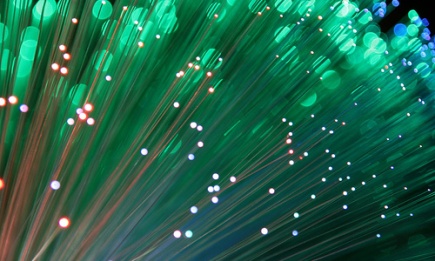Leap forward for extremely fast internet

What can you get when you combine graphene with metallicnanostructures? Improved harvesting light by graphene, which couldpotentially lead to super-fast Internet.
A team of scientists, which includes Nobel Prize winnersProfessors André Geim and Kostya Novoselov, from the Universitiesof Manchester and Cambridge in the United Kingdom has piecedtogether the puzzle that could enhance the characteristics ofgraphene devices for use as photodetectors in future high-speedoptical communications.
Combining nanostructures and graphene
Combining graphene with metallic nanostructures triggered a hugeenhancement in harvesting light by graphene without losing anyspeed. Not only would this help accelerate the Internet but othercommunications would get a boost as well. A key characteristic ofgraphene devices is that they are very fast, surpassing currentInternet cables.
The scientists placed two closely spaced metallic wires on topof graphene and shone light on this structure. Doing this helpedgenerate electric power. According to them, this simple devicepresents an elementary solar cell.
The biggest challenge for the researchers was dealing with lowefficiency. Graphene is the thinnest material across the globe,absorbing just 3% of light. So the remaining light passes throughwithout contributing to electrical power. To get the results theywanted, the team combined graphene with tiny metallic structuresarranged on top of graphene.
“Great potential in the fields of photonics andoptoelectronics”
Plasmonic nanostructures have helped advance the opticalelectric field felt by graphene and have concentrated light withinthe carbon layer, which has a thickness of one atom.
“Graphene seems a natural companion for plasmonics,” saysManchester’s Dr Alexander Grigorenko. “We expected that plasmonicnanostructures could improve the efficiency of graphene-baseddevices but it has come as a pleasant surprise that theimprovements can be so dramatic.”
For his part, Professor Novoselov, also from the University ofManchester, commented: “The technology of graphene productionmatures day-by-day, which has an immediate impact both on the typeof exciting physics which we find in this material, and on thefeasibility and the range of possible applications. Many leadingelectronics companies consider graphene for the next generation ofdevices. This work certainly boosts graphene’s chances evenfurther.”
Commenting on the findings, Cambridge’s Professor Andrea Ferrarisaid: “So far, the main focus of graphene research has been onfundamental physics and electronic devices. These results show itsgreat potential in the fields of photonics and optoelectronics,where the combination of its unique optical and electronicproperties with plasmonic nanostructures, can be fully exploited,even in the absence of a bandgap, in a variety of useful devices,such as solar cells and photodetectors.”
Interested in reading more about Nobel Prize winner AndréGeim? Click here (in Dutch)
Meest Gelezen
Wederom intimidatie van journalisten door universiteit, nu in Delft
‘Burgerschapsonderwijs moet ook verplicht worden in hbo en wo’
Raad van State: laat taaltoets nog niet gelden voor hbo-opleidingen
Vrouwen houden universiteit draaiende, maar krijgen daarvoor geen waardering
Extra geld voor bètafaculteiten is daar nooit terechtgekomen

